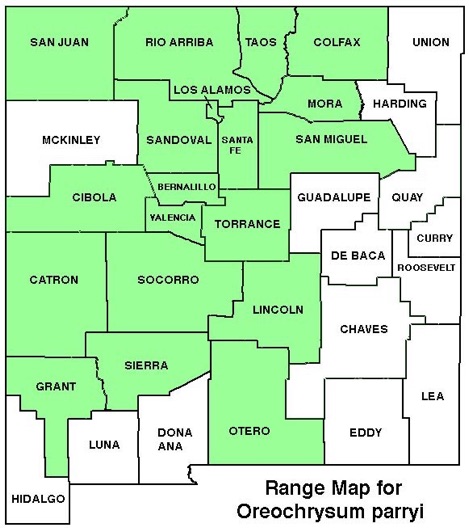WILDFLOWERS OF NEW MEXICO

Spreading by rhizomes, this common, understory plant of conifer forests has leafy stems 12–18-inches tall with clusters of flower heads. Note the spatula-shaped to elliptic basal leaves, the leafy bracts beneath the yellow flower heads, and clasping to partially clasping leaves.
FLOWER: July–September. Stems bear spreading clusters of 3–6 flower heads, each 1-inch wide (25 mm) with 12–20 narrow, yellow ray florets not tightly crowded around the yellow disk; hair-like pappus around each floret is bristle-like; phyllaries cupping flower head stacked in 3–4 unequal rows, tips green, pointed, curling back, hairy or not; leaf-like bracts grow beneath flower head.
LEAVES: Basal and alternate on stem. Blades usually clasping, 2 3/8–6-inches long (6–15 cm), elliptic, tips pointed, margins entire.
HABITAT: Moist to dry sandy, gravelly soils, meadows, open woods, roadsides; ponderosa-oak, Douglas fir, spruce-fir, aspen forests, tundra.
ELEVATION: 7,000–12,800 feet.
RANGE: AZ, CO, NM, NV, UT, WY.
SIMILAR SPECIES: Goldenrods, Solidago species, have crowded flower heads, small rays, but not the leafy bracts.
NM COUNTIES: Western 2/3 of NM in mid- to high-elevation, forested habitats: Bernalillo, Catron, Cibola, Colfax, Grant, Lincoln, Los Alamos, Mora, Otero, Rio Arriba, San Juan, San Miguel, Sandoval, Santa Fe, Sierra, Socorro, Taos, Torrance, Valencia.

PARRY'S GOLDENWEED
OREOCHRYSUM PARRYI
Aster Family, Asteraceae
Perennial herb

THE CONTENTS OF THIS WEBSITE ARE COPYRIGHTED AND CANNOT BE USED
WITHOUT PERMISSION OF GEORGE OXFORD MILLER



• Leaf-like bracts beneath the flower (lower arrow).
-
•Phyllaries below the rays in 3-4 unequal rows with pointed tips that bend back (middle arrow).
-
•Stem leaves clasp the stem (lower arrow).




Stem leaves alternate, clasping.

Basal leaves elliptic to spatula-shaped.
EMAIL ME